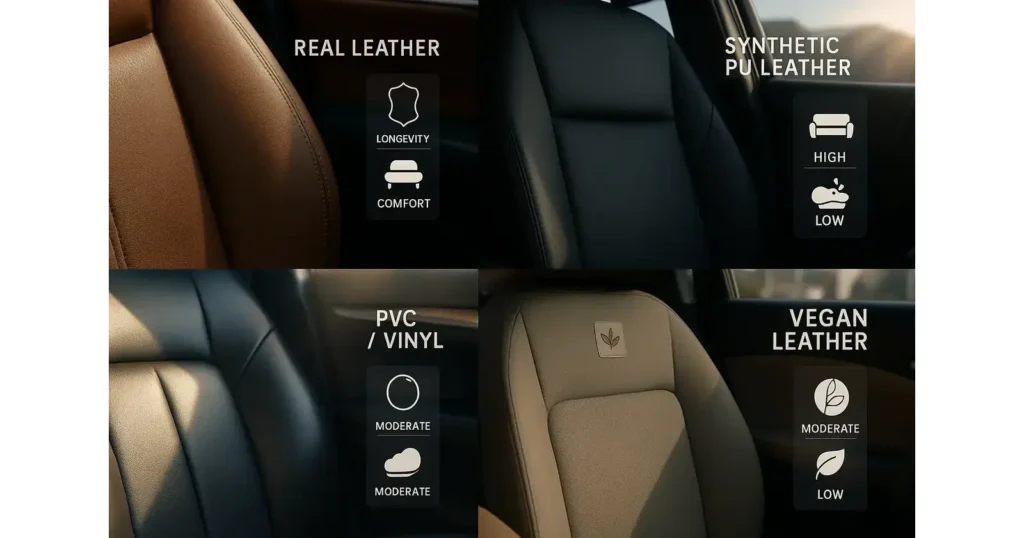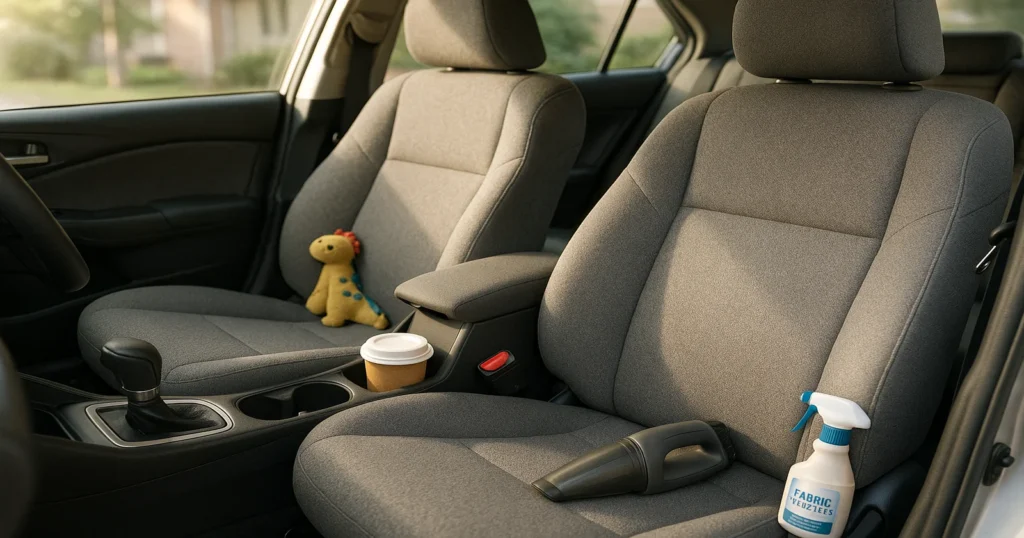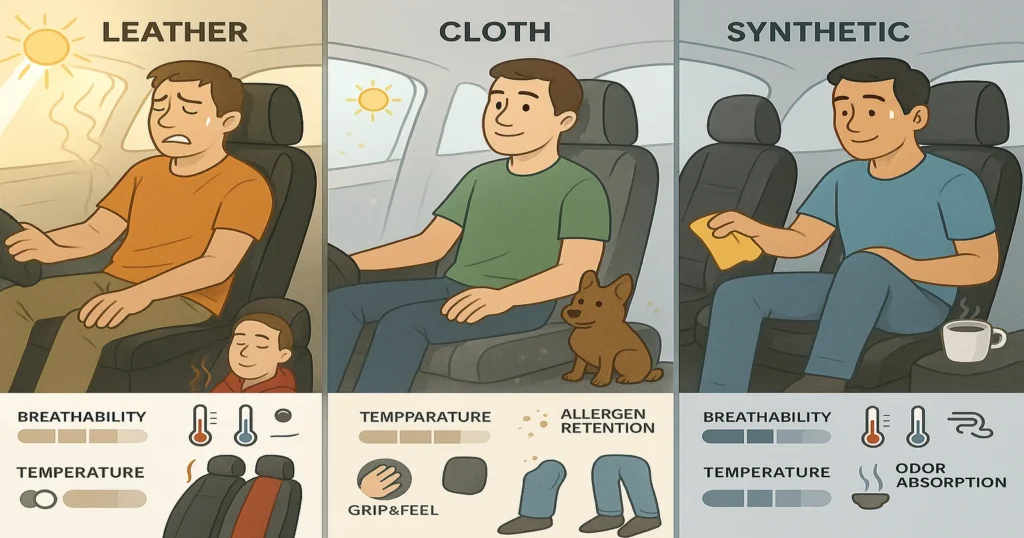The choice of car interior material affects durability, comfort, maintenance and even environmental impact. Drivers seek durability, comfort, low maintenance, and often eco-consciousness when picking upholstery
Here, we will compare real leather, various synthetic options (PU, PVC/vinyl, vegan), and cloth seats in detail. We also explore longevity, care tips, cost, breathability, allergies and sustainability. Each section draws on real-world data and expert insight to help you make an informed decision.
Durability and value depend largely on seat material. Hard-wearing leather can last many years with proper care, while cloth or low-grade vinyl may tear or stain sooner. Maintenance needs vary: leather and vinyl wipe clean easily, but require periodic conditioning to stay supple. Comfort and thermal behavior also differ. Leather insulates and can feel hot under sun or cold in winter, whereas cloth often stays milder. Finally, ethical or sustainability concerns come into play. Leather implies animal products, whereas many synthetics derive from petroleum (PVC, PU). New plant-based leathers aim to reduce environmental impact. Decisions hinge on weighing these trade-offs – longevity and luxury versus cost and eco-friendliness.
Real Leather vs Synthetic vs Cloth vs PVC vs Vegan Leather

Seat materials fall into several categories. Below we compare real leather, PU (polyurethane) faux leather, PVC/vinyl, cloth/fabric, and vegan/plant-based leather. Each has distinct benefits and drawbacks.
Real leather is prized for its luxurious look, soft feel, and strength. Tanned animal hides resist tearing; top-quality leather seats last for decades when well-maintained. Leather naturally breathes better than most synthetics, so it can feel more comfortable in moderate climates. It also wipes clean easily, shedding dirt and liquid spills more readily than cloth.
On the downside, leather is expensive and requires regular care. Without cleaning/conditioning, hides dry out and crack (as sources note, neglected leather “can start to crack and tear”. Exposure to sun can make leather scorchingly hot in summer, and very cold in winter. Some drivers cover or heat/cool their seats to mitigate that. Real leather also carries ethical considerations for some buyers. In short, leather seats offer top-tier luxury and longevity if you have the budget and commitment to maintain them.
PU leather (also called vegan pleather) is a plastic-based leatherette often used in car interiors. It is made by coating fabric backing with polyurethane. PU leather is usually cheaper than genuine leather yet aims to mimic its appearance. It is durable and water-resistant, so it endures spills without staining. PU seats clean up easily with a damp cloth or mild cleaner. Some modern PU blends even add breathe-through laminates or micro-holes to improve airflow. However, PU leather has drawbacks: it tends to be less breathable than natural leather or cloth, which can make seats feel sticky or hot during summer.
Over time, PU can crack or peel, especially if exposed to UV and extreme temperatures. In fact, experts note that unlike leather which develops a patina, PU degrades under stress (bubbles or cracks) and cannot be conditioned like animal hides. Good quality PU seat covers often include a thin foam layer for comfort and may outlast cheap vinyl, but typically they won’t match leather’s 20+ year lifespan. Still, PU is a cost-effective, stylish option – many luxury cars use high-grade PU (sometimes called ultra-leather or trademarked names) that feels quite premium. Regular cleaning is all that’s needed (no special conditioner), but expect to replace PU upholstery after roughly 8–10 years of heavy use.
PVC or vinyl seating is another leather alternative. Vinyl comes from polyvinyl chloride – a plastic – and is often the cheapest material for upholstery. It offers easy cleaning and good water resistance. Like PU, vinyl can look glossy like leather and is used in many entry-level car trims. Unlike leather, vinyl is not breathable and amplifies heat/cold effects even more. The Capital One guide cautions that vinyl seats can tear easily and get just as hot or cold as real leather. Vinyl may also emit strong chemical odors when new, and some studies note it can off-gas phthalates (plasticizers) over time. These phthalates are linked to health concerns. In general, vinyl seats will last less than leather or good PU. They’re a budget-friendly choice (often standard on base models), but luxury and durability are limited.

Cloth or fabric is a traditional choice for car interiors. Usually made of woven polyester or nylon blends, cloth seats are affordable and widely used in base models. Cloth is naturally more breathable and stays cooler in heat (as research shows, cloth’s thermal effusivity is much lower than leather’s, meaning cloth won’t feel as hot after sun exposure). It remains relatively comfortable in extreme cold as well. Cloth seats feel softer and grippier (useful for spirited driving), and initial purchase cost is low.
On the downside, cloth stains easily – sweat, spills or dirt can be hard to remove and may lead to odors if not cleaned quickly. Cloth also absorbs odors (e.g. smoke, pets) more than leather. It tends to wear out sooner under heavy use, showing faded color or thinning fabric, especially on high-contact areas. For families or commuters, cloth can hide wear from kids and pets (unlike peeling vinyl), but it traps dust and allergens. Experts recommend vacuuming and occasionally shampooing fabric seats. Many owners use removable cloth seat covers to protect the original upholstery. Overall, cloth offers good comfort and cold-weather resilience, but demands more upkeep to keep it looking fresh.
Recent innovations give us plant-derived “leather” options. Companies make upholstery out of cactus, pineapple leaves (Piñatex), apple peels, mushrooms and more. For example, BMW uses cactus leather (Deserttex) in some interiors, and smaller brands experiment with pineapple leather and mushroom leather. These vegan leathers avoid animal use and often have lower carbon footprints during production. Certification-wise, many follow standards like OEKO-TEX for harmful substances. However, many plant-based leathers still contain plastic binders to hold them together.
Thus they often share PU’s characteristics (lightweight, water-resistant) but may be less supple. Advantages: they can be very eco-friendly (often biodegradable) and often look unique. Downsides: newer materials may feel different from conventional leather, and long-term durability is still being proven. Currently, plant-leather interiors are rare and often pricey. If sustainability is a priority, look for trim options labeled “cactus leather” or similar, and check if they carry eco-certifications. (Note: Tesla’s early vegan leather interiors, for instance, faced issues like bubbling when exposed to oils – this underscores that not all vegan seats behave like leather.) In summary, plant-based leathers represent an exciting trend but are still evolving in performance.
Car seat sustainability covers material sourcing, manufacturing impacts, and end-of-life. Genuine leather comes from livestock byproducts, so it leverages animal hides but involves heavy processing with chemicals and water. Ethical buyers may be concerned about tanning pollution. Responsible leather brands pursue Leather Working Group (LWG) certification, which audits tanneries for environmental standards. Also, the OEKO-TEX® Leather Standard tests hides for thousands of harmful substances.
For example, OEKO-TEX ensures any leather labeled as such is proven free from toxins like heavy metals and formaldehyde. These certifications and audits help trace quality. By contrast, synthetic PU and PVC leathers are derived from fossil fuels. They emit more greenhouse gases in production and don’t biodegrade, often releasing microplastics and volatile compounds as they wear. Some newer PU leathers use water-based processes to cut solvent use, but plastic waste remains a concern. Cloth seats vary: polyester fabrics are plastic-based too (similar environmental issues), while natural fabrics (like wool blends) use more land and care.
On the forefront, plant-based leathers and fabrics shine in sustainability. Cactus leather and apple leather use agricultural byproducts and need far less water than cattle. Pineapple leather is made from waste leaves of pineapple harvests. Mushroom leather is grown from fungal mycelium on wood waste. These materials are mostly biodegradable or recyclable.
For instance, these new leathers often meet OEKO-TEX or Sustainable Textile Standard criteria for low toxins. However, until these products scale up, their certification options are limited. One should ask dealers for “vegan leather” but verify if it’s certified (look for labels like OEKO-TEX Made in Green, Bluesign, or bespoke vegan leather audits). Overall, if eco-impact is a key concern, plant-based interiors (or certified leather from ethical tanneries) are the best choice, albeit at a premium.
Longevity depends on use and care. Below are care tips and durability notes for each material:
Trusted car care brands make cleaners/conditioners for each material. For leather: a pH-neutral leather cleaner plus a nourishing conditioner (e.g. lanolin-based). For vinyl: a vinyl/plastic cleaner and protectant spray to prevent UV cracking. For cloth: a fabric/upholstery shampoo or a mild soap (Woolite) and a brush. Eco-friendly kits exist (plant-derived cleaners). Always test cleaners on a small patch first.
For torn leather or vinyl, keep a leather repair kit (color-matched compounds, filler). Many cracks or scratches can be fixed DIY. For burnt or deeply ripped seats, professional reupholstery may be required. In contrast, a ripped cloth panel can often be stitched or patched by a tailor or seat shop at low cost.
In real-world comparisons, leather often outlasts synthetics. For example, owners note that a well-kept 10-year-old leather interior still looks better than a synthetic one of the same age. By year 5, cheap vinyl may already show peeling, whereas leather just softens. However, leather can fade in scorching sun if unprotected. Cloth can shrink or sag after many washes, whereas leather just gets softer.
A simple test: leave identical leather and cloth seat covers in a parked car for 30 minutes in mid-summer. The leather surface temperature often reaches 15–20°F higher than the cloth, feeling much hotter to sit on. Conversely in winter, cold leather feels several degrees chillier. This highlights that thermal comfort and maintenance (like using sunshades) are part of longevity: materials that stay cooler/hotter less will crack or fade more slowly.

Comfort and feel vary by season and use:
Comfort Test Example: In a 30-minute summer drive, cloth seats will keep back sweat minimal. Leather might result in a sweaty back unless ventilated or conditioned (air conditioning on). Drivers with back problems often prefer cloth or perforated leather to improve airflow.
In summary, cloth shines in raw comfort (softness, temperature regulation, allergy-friendliness) while leather shines in ease of cleaning and longevity. Synthetic materials fall in between: PU leather can feel “almost leather-like” and easy to clean, but will trap heat and feel less natural; PVC is similar but usually with lower comfort.
Initial and lifetime costs differ widely:
Overall, you can prepare a decision matrix: for a strict budget shopper, cloth or vinyl is economical but expects sooner replacement. For a luxury seeker, leather (or top-tier PU) is best – it costs more upfront but typically lasts and adds resale value. For eco-conscious buyers, factor in the premium of plant-based materials or certified eco-leathers, which might outweigh raw cost savings but align with values.
| Material | Initial Cost | Lifespan | Maintenance Cost | Resale Impact |
|---|---|---|---|---|
| Leather | High | Very High (15–20 yrs) | High (conditioning) | Adds value |
| PU Leather | Medium | High (7–10 yrs) | Low (wiping) | Neutral/Positive |
| PVC/Vinyl | Low | Medium (5–7 yrs) | Low (wiping) | Neutral/Negative |
| Cloth | Low | Medium (5–7 yrs) | Medium (cleaning) | Negative |
| Plant-based | Very High | Unknown (~PU) | Low (varies) | Niche market |
(This table is a conceptual illustration.)

Choosing the best material depends on your priorities and lifestyle. Consider these factors:
Decision Flow (Example): Start at “Is budget high?” – if yes, consider leather or vegan leather. If not, go to “Is ease of cleaning critical (kids/pets)?” – if yes, prefer leather/PU; if no, cloth is acceptable. Next, “Is summer heat a concern?” – if yes, lean cloth/perforated; if no, full leather is okay. Use these criteria to narrow down.
Each buyer profile differs. For instance, an eco-minded driver might pay a premium for apple- or cactus-based leather, while a sports car enthusiast often opts for leather or Alcantara inserts for grip and prestige. A ride-share driver may want stain-resistant synthetic for easy cleaning. Think through what matters most and ask dealerships detailed questions about seat materials and warranties.
Choosing car seat materials is a multi-faceted decision. Here are the key takeaways:
In essence, no one material is “best” for everyone. Leather and top-tier synthetics offer luxury and lifespan. Cloth offers affordability and comfort. Plant-based materials promise greener credentials. Use the decision factors above – comfort, climate, cost, care – as a roadmap. Whichever you pick, proper care will maximize its life: clean spills promptly, condition if needed, and use protectants against UV.
IsItRealLeather began with one goal: to defend and promote authentic leather in a world full of cheap substitutes. We’re not a brand or manufacturer—we are a community-driven resource backed by writers, leather crafters, and passionate consumers from around the world.
Sign up, you’ll love hearing from us. We promise!